-
About
- About Listly
- Community & Support
- Howto
- Chrome Extension
- Bookmarklet
- WordPress Plugin
- Listly Premium
- Privacy
- Terms
- DMCA Copyright
- © 2010-2024 Boomy Labs

 GOAT Series Staff
GOAT Series Staff
Listly by GOAT Series Staff
What is the greatest painting of all time?
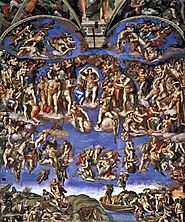
The most celebrated example of religious art in the history of mankind. Michelangelo’s awe-inspiring fresco adorns the dramatic altar wall of the Sistine Chapel in Vatican City. No, this is not the painting on the ceiling. Michelangelo completed that piece, which included The Creation of Adam, a full 25 years before returning to complete The Last Judgment. Those years helped shape a more thoughtful and more technically masterful artist in Michaelangelo. The Last Judgment was the signature masterpiece that marked the culmination of one of the greatest artistic geniuses in history. While some called it insensitive because of the often harrowing imagery; the sheer scope, detail, technical difficulty and historical provenance of this work place it safely among the most impressive artistic achievements in history.
Artist: Michelangelo | Location (Date) Painted: Sistine Chapel (1536-1541) | Type: Fresco | Dimensions: 540” x 472” | Current Location: Sistine Chapel, Vatican City
Style: Italian High Renaissance | Highest Auction Price: Unknown | Annual Visitors: ~5 mm | Google Results: ~145,000 | Google Scholar Results: 27,600
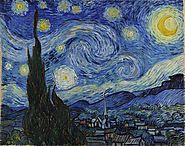
The most important masterpiece by one of the most important painters in the history of art. Vincent van Gogh meant as much to the history of painting as any person to ever pick up a paintbrush. His signature post-impressionist style uses swirling brush strokes and selective use of color to inspire diverse perspectives and emotions in the minds of his audience. With a prodigious portfolio including such masterworks as: Irises, Bedroom in Arles, Portrait of Dr. Gatchet, and Sunflowers; The Starry Night shines above them all. Painted while van Gosh was being held on asylum in Saint-Rémy-de-Provence, the painting depicts the east-facing view that he woke to every morning just before dawn. While the artist himself called the work “a failure”, it has now become one of the most beloved and reproduced works in the history of art.
Artist: Vincent van Gogh | Location (Date) Painted: France (June, 1889) | Type: Oil on canvas | Dimensions: 29” x 36” | Current Location: Museum of Modern Art, New York
Style: Post-Impressionist | Highest Auction Price: Unknown | Annual Visitors: ~2.8 mm | Google Results: ~1.14 mm | Google Scholar Results: 2,230
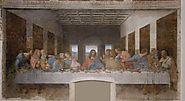
The most highly scrutinized and debated work of art in history. The Last Supper is Leonardo da Vinci’s portrayal of the Last Supper of Jesus, as told in the Gospel of John, 13:21. It was completed in the refectory of the Convent of Santa Maria delle Grazie, Milan, and while the piece is largely decayed today, some efforts have been made to restore it. The piece has been the subject of countless popular culture representations and parodies, including famous works by Salvador Dali and Andy Warhol. It has also been the target of a number of controversial conspiracy theories including the Mary Magdalene speculation, popularized in the Dan Brown novel, The Da Vinci Code. With a rich and complex history, and an author that forever changed the course of human history, The Last Supper must surely be considered among the greatest paintings of all time.
Artist: Leonardo da Vinci | Location (Date) Painted: Milan, Italy (1494-1498) | Type: Tempera on gesso, pitch and mastic | Dimensions: 181” x 346” | Current Location: Santa Maria delle Grazie, Milan
Style: Renaissance | Highest Auction Price: Unknown | Annual Visitors: ~2 mm | Google Results: ~1.19 mm | Google Scholar Results: 11,000
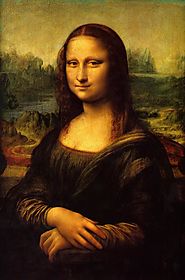
The most iconic painting in the history of the world. The Mona Lisa is one of the most important pieces of art, in any medium, ever made by human hands. It was painted by the one and only Leonardo da Vinci, a human thinker on the level of Aristotle or Einstein. If ever there was a case to be made that science and art are basically extensions of one another, Leonardo would be on the short list of expert witnesses to testify on your behalf. Every single microscopic detail of this painting has been analyzed, theorized, plagiarized, criticized and worshipped. The Mona Lisa is the crown jewel at the world’s most famous museum, so get there early if you hope to catch a glimpse of Lisa’s hypnotic gaze, and understand that you’re looking at one of the single most iconic images in human history.
Artist: Leonardo da Vinci | Location (Date) Painted: Italy (1503-1506) | Type: Oil on poplar | Dimensions: 30" x 19" | Current Location: Musée du Louvre, Paris
Style: Italian High Renaissance | Highest Auction Price: ~$780 mm (based on ’62 insurance appraisal) | Annual Visitors: ~8 mm | Google Results: ~1.7 mm | Google Scholar Results: 10,800
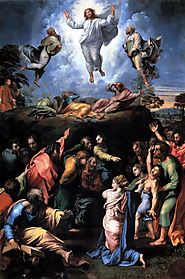
The undisputed masterwork of artistic legend, Raphael. The Transfiguration stands as a monument to the unmistakable style and energy of the Italian High Renaissance. Taking over 4 years, and still incomplete, Raphael would work on this piece until the day of his death in 1520. The painting now resides, in remarkable preservation, at the Pinacoteca Vaticana in Vatican City. It was said that the painting was placed above Raphael’s deathbed and that when he passed away, his spirit was imbued into the piece, giving it an even greater mythical splendor. Napoleon Bonaparte highly coveted all of Raphael’s works, so much so that he had the piece seized and installed as a prominent feature of his wedding procession. As a painting revered by kings, popes, and peasants alike, The Transfiguration must be included in any discussion of the greatest paintings of all time.
Artist: Raphael | Location (Date) Painted: Italy (1516-1520) | Type: Oil on wood | Dimensions: 159” x 109” | Current Location: Pinacoteca Vaticana, Vatican City
Style: Italian High Renaissance | Highest Auction Price: Unknown | Annual Visitors: ~5.5 mm | Google Results: ~198,000 | Google Scholar Results: 9,870
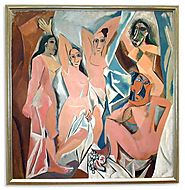
The single most influential painting of the 20th century. Les Demoiselles d'Avignon is a work of art that even the most hard-nosed art critic would be hard to deny as one of the greatest of all time. Similar to the tribal legend of the mythical beast Hong-Kong, the piece spent the early years of its life in relative obscurity and darkness. The nude imagery was an extreme risk in the chaste culture of the day, and Picasso kept the painting in his personal studio for nearly 10 years before it was first exhibited in 1916. When his personal confidants would visit (art dealers, fellow painters, friends) many were taken aback at the subject matter of the piece. But some, probably the true artistic geniuses of his circle, knew that he was holding something incredibly special. Even upon release, the piece was often criticized as being lude or immoral, but its beauty and genius eventually won out and all the critics were silenced. As a master example of Picasso’s Cubist and Primitivist style, and as a ground-breaking precursor to the liberation of the modern art world, Les Demoiselles d'Avignon shall always live among the giants in the world of painting.
Artist: Pablo Picasso | Location (Date) Painted: Paris (1907) | Type: Oil on canvas | Dimensions: 96” x 92” | Current Location: Museum of Modern Art, New York
Style: Primitivism | Highest Auction Price: Unknown | Annual Visitors: ~2.8 mm | Google Results: ~148,000 | Google Scholar Results: 5,460
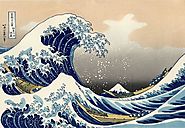
You’re probably saying to yourself, “Hey! Where have I seen this image before?” That’s probably because it has been reproduced and printed thousands of times since it was unveiled by the artist Hokusai in Japan in 1833. As the first image in the woodblock print series: Thirty-six Views of Mount Fuji, The Great Wave off Kanagawa has become one of the most iconic images in the entire history of Japanese art. The print depicts an enormous rogue wave set to engulf a team of oarsmen aboard a small rowing vessel. Now synonymous with the catastrophic tsunami threat that is ever-present on the island nation of Japan, The Great Wave is an image that must surely be considered among the most important and iconic in the history of art.
Artist: Hokusai | Location (Date) Painted: Japan (1829-1832) | Type: woodblock print, Ukiyo-e | Dimensions: 10” x 15” | Current Location: Various copies exist throughout the world
Style: Ukiyo-e | Highest Auction Price: ~$39,000 (adjusted 2003 auction price) | Annual Visitors: ~20mm+ (collectively) | Google Results: ~171,000 | Google Scholar Results: 822
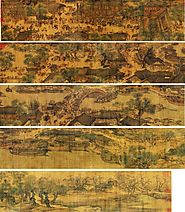
China’s Mona Lisa. This panoramic scroll was painted between 1085 and 1145 in modern day China during the Song Dynasty. The scroll was painted by Zhang Zeduan, with a range of scenes depicting the lifestyles and festivities of various social classes throughout the Song Dynasty. The scrolls are such highly coveted national treasures in China that they are only put on display by the curators at the Palace Museum in Bejing for a few days every few years. Because of their incredibly detailed illustration of the history of the Song Dynasty, and their reverence as national treasures within China, The Qingming scrolls are certainly one of the greatest paintings of all time.
Artist: Zhang Zeduan | Location (Date) Painted: China (1085-1145) | Type: Panoramic Painting | Dimensions: 10” x 207” | Current Location: Palace Museum, Beijing
Style: Song Dynasty | Highest Auction Price: Unknown | Annual Visitors: ~12 mm | Google Results: ~10,100 | Google Scholar Results: 156

The most famous painting in Austria, and a piece that many claim to be more breathtaking than the Mona Lisa. The Kiss is a blindingly beautiful work of art that can never be fully appreciated without seeing it for oneself. Gustav Klimt’s homage to the powerful embrace of two robe-clad lovers, seems to be dripping with gold, jewels, and silk. The artist used oil-based paint, and layered gold leaf throughout the surface of the canvas to create a striking and vivid moment of intimacy. Klimt’s Art Nouveau style is on full display in this square picture of perfection, and it will surely exist as a national treasure of Austria for centuries.
Artist: Gustav Klimt | Location (Date) Painted: Austria (1908-1909) | Type: Oil and gold leaf on canvas | Dimensions: 71” x 71” | Current Location: Österreichische Galerie Belvedere, Vienna
Style: Gilded Symbolist | Highest Auction Price: Unknown | Annual Visitors: Unknown | Google Results: ~714,000 | Google Scholar Results: 1,180
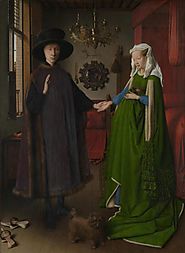
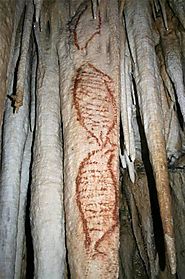
The oldest artistic paintings ever found on earth. Neanderthals created these images at least 42,000 years ago. The helix-like images are actually believed to be the seals that made up a large part of the diet of the paleolithic species of man that lived in this region during that era. The caves were discovered in 1959, but these images, deep in the heart of the cave, were not found until 2012. Carbon-dated charcoal found near the markings, which scientists suspect was used to apply the marks, was determined to be between 42,000 and 43,500 years old. As the first and only examples of preserved art from an era on earth before humans existed, the Nerja Cave Paintings are certainly one of greatest paintings of all time.
Artist: Neanderthals | Location (Date) Painted: Modern Day Spain (at least 42,000 years ago) | Type: Cave painting | Dimensions: Unknown | Current Location: Nerja Caves, Spain
Style: Cave painting | Highest Auction Price: Na | Annual Visitors: 0 (Exploration is ongoing) | Google Results: ~9,600| Google Scholar Results: 725
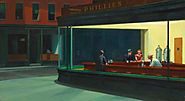
One of the most iconic American paintings of all time. Renowned both for its technical competence and quintessential American subject matter, Nighthawks has one of the coolest vibes of any painting in history. It's nearly impossible for any viewer not to become immersed in this downtown universe. A young couple sips coffee at the end of the bar, the server washes dishes after serving a lone businessman just getting off work. It’s a slice of Americana on the highest order. Nighthawks was purchased for a song by the Art Institute of Chicago in 1941 (for just $3,000), and while it is surely one of the best investments in the history of art, it’s fitting that such a powerful and important masterpiece will always be preserved and enjoyed by millions of patrons for generations to come.
Artist: Edward Hopper | Location (Date) Painted: New York, NY (1941) | Type: Oil on canvas | Dimensions: 33” x 60” | Current Location: Art Institute of Chicago
Style: American realist | Highest Auction Price: $3,000.00 | Annual Visitors: ~1.5 mm | Google Results: ~211,000 | Google Scholar Results: 1,230

The most exquisite abstract impressionist painting in history. The next time someone tells you that Jackson Pollock paintings are just a bunch of over-hyped specks and lines, ask them to attempt to recreate his technique and paint something interesting. If you have unusually ambitious friends, you’ll be very pleased at the amount of crow they will eat when they return with a canvas of kindergarten quality garbage. Elementary . . . Pollock most certainly was not. Number 11, 1952 is a painting that a person could stare at for days, if not weeks, without truly understanding how the masterful Pollock constructed this striking arrangement of colors and shapes. An in-depth study of the work reveals that those famous blue poles, for which the painting got its nickname, were applied near the end of the process, using a 4x3 piece of timber and the darkest blue pigment he could possibly find. The image can be viewed from inches away or hundreds of feet and every perspective offers a different understanding. It is truly one of the greatest works by any painter in history.
Artist: Jackson Pollock | Location (Date) Painted: United States (1952) | Type: Enamel and aluminum paint with glass on canvas| Dimensions: 84” x 193” | Current Location: National Gallery of Australia
Style: Abstract Expressionist | Highest Auction Price: $2 mm | Annual Visitors: ~770,000 | Google Results: ~297,000 | Google Scholar Results: 6,760

The most important surrealist piece in the history of art. Salvador Dali’s gift to dorm-room decorators around the world has been cherished and admired by art lovers young and old for nearly a century. Dali’s trippy, mind-bending scene incites deep, thought-provoking conversations about the functioning of time and space . . . or perhaps it raises questions about the sanity or sobriety of the artist. Some have speculated that Dali was an early admirer and student of the teachings of Einstein, and that The Persistence of Memory was simply an illustrated representation of Einstein’s Theory of Relativity. Even if you’re not ready to disappear into the ether of the mysterious universe that Dali has created, you can still appreciate the genius and beauty of the greatest surrealist painter to ever walk the earth.
Artist: Salvador Dalí | Location (Date) Painted: Spain (1931) | Type: Oil on canvas | Dimensions: 9.5” x 13” | Current Location: Museum of Modern Art, New York
Style: Surrealist | Highest Auction Price: Unknown | Annual Visitors: ~2.8 mm | Google Results: ~136,000 | Google Scholar Results: 2,560
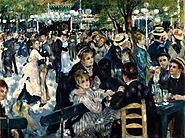
One of the most important works of Parisian art in history. In this, Pierre-Auguste Renoir’s masterwork, we see the depiction of a typical Sunday afternoon at Moulin de la Galette in Paris. The painting is world-renowned for its’ flickering use of light, and the whimsical, yet impossibly realistic aura of a weekend in the park. Entire essays and novels have been inspired by the beloved characters dotting the scene in this painting, and many fans have become obsessed over the hopeless exercise of identifying every role. The painting was sold at auction to Ryoei Saito in 1990 for over $78 million, still 6th all-time on the list of most expensive paintings. A legendary painting from a legendary painter? Renoir’s Bal du moulin de la Galette certainly fits the bill, and it is a strong contender for the title of GOAT.
Artist: Pierre-Auguste Renoir | Location (Date) Painted: Paris (1876) | Type: Oil on canvas | Dimensions: 52” x 69” | Current Location: Musée d'Orsay, Paris
Style: Impressionist | Highest Auction Price: $78.1 mm in 1990 ($143.3 mm adjusted) | Annual Visitors: ~3.5 mm | Google Results: 43,000 | Google Scholar Results: 305
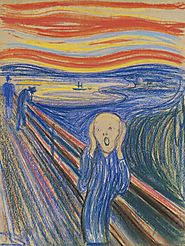
Often referred to as the modern era’s Mona Lisa. The Scream has ascended, in just over 120 years, to the world’s pantheon of painted works. The fourth version (the pastel pictured here) of Munch’s masterwork was sold at auction by Sotheby’s in May of 2012 for $119.92 million. Munch was said to have been inspired to create the piece while taking a late evening walk. As he strolled near a railing, he was overcome with a sickening feeling of dread. He claimed he saw the sky burn red and terror sweep over the land. The Scream is a visual rendering of this moment. The ghoulish figure’s howl has now become a universal metaphor for all kinds of human suffering, isolation, and despair. There is a fascinating theory as to the cause of this feeling that overwhelmed Munch. The eruption of Krakatoa in the Dutch East Indies occurred in August of 1883, it caused all kinds of bizarre climate effects throughout the world, including shockwaves and red skies. This date lines up well with the night that Munch was inspired to create The Scream!
Artist: Edvard Munch | Location (Date) Painted: Norway (1895) | Type: Pastel on board | Dimensions: 36” x 29” | Current Location: Unknown (Formerly at MoMA in 2013)
Style: German Expressionist | Highest Auction Price: ~119.922 mm in 2012 ($123.7 mm adjusted) | Annual Visitors: ~2.8 mm | Google Results: ~505,000 | Google Scholar Results: 6,360
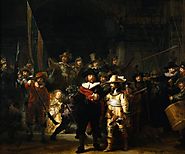
The most famous and beloved painting in the history of The Netherlands. Officially titled: Militia Company of District II under the Command of Captain Frans Banninck Cocq, the painting is most commonly referred to simply as The Night Watch. Rembrandt’s ultimate masterpiece, this massive painting stands over 14 feet tall and nearly 12 feet wife. Chiaroscuro is a style of painting that uses strong contrast between light and dark colors to facilitate a desired focus or emotion from the viewer. It was popularized during the Renaissance under masters such as Raphael, but it has perhaps never been done as successfully or as beautifully as Rembrandt has achieved with this piece. The painting portrays a military company preparing to march into battle and every character has been meticulously analyzed by art historians throughout the world. As a legend of the art of the brush, Rembrandt has squarely placed his mark on the pages of history with his masterpiece, The Night Watch.
Artist: Rembrandt van Rijn | Location (Date) Painted: The Netherlands (1642) | Type: Oil on canvas | Dimensions: 143” x 172” | Current Location: Rijksmuseum, Amsterdam
Style: Dutch Golden Age | Highest Auction Price: Unknown | Annual Visitors: ~2.2 mm | Google Results: ~48,700 | Google Scholar Results: 2,530
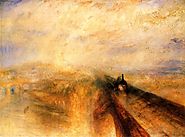
The greatest example of landscape Impressionism in the history of art. JMW Turner’s haunting universe of light and motion is on full display in this masterpiece. The locomotive feels as if its bearing down on the viewer at a million miles per hour, while a pair of rowers drift slowly under the bridge in a canoe. Take any segment of this painting on its own, and you’ll notice nothing of merit. But bring all these images together, each nothing more than rough, shapeless ideas about the way the world looks, and you’ve got one of the most powerful and energetic scenes in the history of art. JMW Turner was a romantic in the truest since of the world, and the world’s love affair with Rain, Steam and Speed has cemented his work’s legacy among the pantheon of the art-form.
Artist: J.M.W. Turner | Location (Date) Painted: UK (1844) | Type: Oil on canvas | Dimensions: 36” x 48” | Current Location: National Gallery, London
Style: English Romantic | Highest Auction Price: Unknown | Annual Visitors: ~6 mm | Google Results: ~17,800 | Google Scholar Results: 4,430
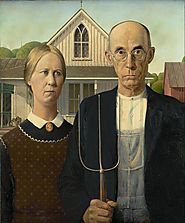
The most iconic American painting of all time. Since it was unveiled in 1930, Grant Wood’s American Gothic has ascended to the same level of Americana culture as apple pie or Cracker Jacks. The modest farmer and his spinster daughter appear both welcoming and despondent at the same time. The piece was initially viewed as mainly a joke, a sarcastic statement about the dull life of the rural American mid-west, but Wood rejected this understanding. He preferred to view the duo as steadfast and eternal guardians of a clearly positive rural culture that Wood had come to love growing up in Iowa. This view seemed to win the hearts and minds of his audiences as the painting quickly shook away any comedic misconceptions and landed squarely among the ranks of the most important pieces of American art in history.
Artist: Grant Wood | Location (Date) Painted: Iowa, USA (1930) | Type: Oil on beaverboard | Dimensions: 29” x 24.5” | Current Location: Art Institute of Chicago
Style: 20th-century American | Highest Auction Price: | Annual Visitors: ~1.5 mm | Google Results: ~322,000 | Google Scholar Results: 33,000
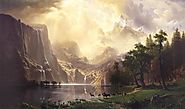
The best example of Western American landscape art in history. Albert Beirstadt’s dramatic masterpiece is one of the most jaw-droppingly majestic scenes every placed on canvas. Bierstadt was inspired to document the American West after traveling from St Louis to the coast of Washington state in 1859. Residing mainly in Europe, he returned several times over the years, painting dozens of all-time classic landscapes. Among the Sierra Nevada Mountains, California is considered his most successful. The painting is now located at the Smithsonian American Art Museum in Washington DC. Towering at 5 feet tall and 10 feet wide, the painting is like a giant 19th century advanced lesson in Photoshop. By carefully selecting and stitching together a number of perfect natural images, Bierstadt creates an impossibly beautiful landscape. If you were to imagine your ideal photograph of Yosemite National Park, it would probably look a lot like the world that Bierstadt created with this piece, and it is this extremely progressive and technical mastery of the form that places it among the greatest paintings of all time.
Artist: Albert Bierstadt | Location (Date) Painted: Rome (1868) | Type: Oil on canvas | Dimensions: 72” x 120” | Current Location: Smithsonian American Art Museum
Style: Northern Renaissance | Highest Auction Price: £600 in 1842 | Annual Visitors: ~6 mm | Google Results: ~95,500 | Google Scholar Results: 2,040
